

Table of contents
- dahlias
- marigold
- lupins
- foxtail
- zinnias
- tagetes
- summer aster
- Cape daisies
- petunias
- scented stone rich
Annual perennials impress with enormous and long-lasting flowers and beautify every garden bed. Annual plants are those varieties that grow from the seeds within a vegetation period, then form foliage and shoots, then flower and finally bear fruit. Normally, their flowering time falls in the summer, some even bloom from spring to autumn. After the new seeds have formed, the plants that are not hardy die off.
dahlias
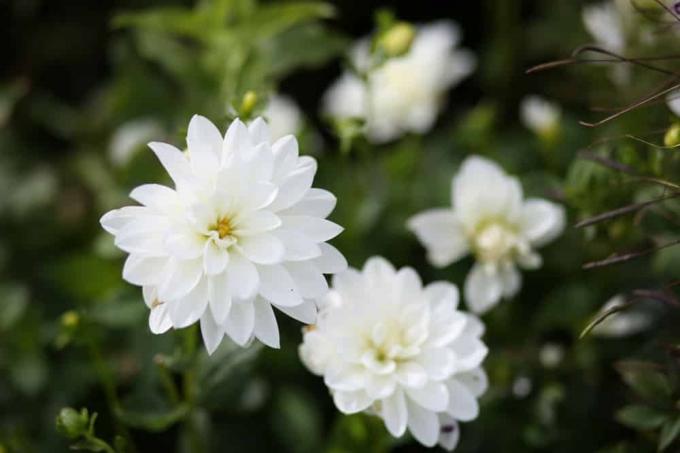
Dahlias transform every garden into a sea of color with their lush and colorful flowers. The coloring is very multifaceted and with different color gradients, there are monochromatic, multicolored, mottled and marbled varieties. The flower shapes also vary, some are compact and spherical, others are large and fringed. In general, dahlias are relatively easy to care for and thrive when the site conditions are right. However, the perennial comes from tropical climes and is not frost hardy, the tubers freeze in winter. The formation of new buds can be stimulated for a long time by appropriate care steps. If the shoot tip is cut off after planting, then this process promotes branching of the plant, which already starts at the bottom. This process is called pinching in botany.
- Many color variants: yellow, pink, orange, red and white
- Flowering time from July until well into autumn
- Prefer sunny locations
- Only plant out after the ice saints
- Gets along with relatively little water
- It is essential to avoid waterlogging, which leads to root rot
- Remove wilting flowers promptly
- Fertilize adequately, several times a month
- Pinch 10 days after planting
marigold

The marigold originally comes from the Mediterranean areas in southern Europe. Thanks to its bright and upright flowers, the plant is very popular with gardeners and fits perfectly into a themed cottage garden. The ornamental plant grows and flowers reliably, ideally planted in a group as a perennial. In this way, the plants can support each other. When it comes to care, it is relatively undemanding, but some factors have to be right when planting. Although the marigold is not frost hardy, it will grow again on its own next year thanks to the hardy seeds. The marigold often goes wild and appears in the vicinity of its first location, for example on public green spaces. The Latin name of the plant is calendula, and it is used both in medicine and in naturopathy because of its healing properties.
- Reaches growth heights of up to 70 cm
- Bright yellow to orange flowers
- Flowering period from May to November
- Blooms continuously and develops new buds continuously
- Makes no great demands on the soil
- Half shade to full sun is ideal
- The more sun, the bigger the blooms
- Water regularly, only tolerates dry phases for a short time
- Fertilize once a month, use fertilizer carefully
- Avoid waterlogging
lupins
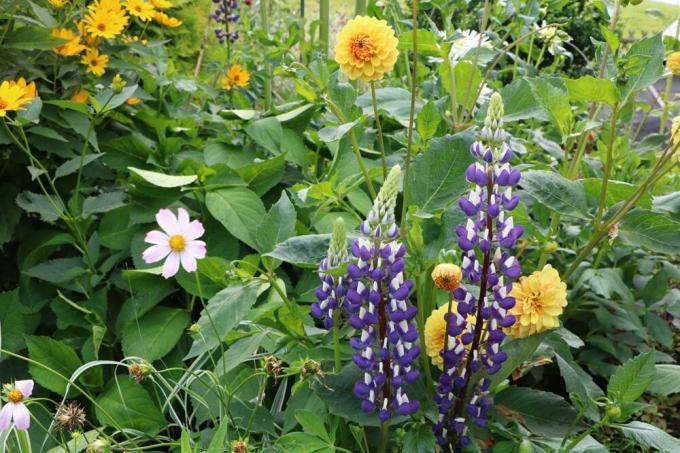
Lupins form impressive inflorescences that have an attractive luminosity. The flowers resemble dewdrops that adorn the plant like precious pearls. The individual flowers of the perennial sit close together and look like compact candles. In addition, there is a wide range of colors to choose from for the flowers. In combination with a flawless foliage and the elegantly shaped foliage, the plant is an ornament for every garden bed. The lupins belong to the legume family and sustainably improve the quality of the soil. The plant is particularly suitable for farm and cottage gardens, which are sorted by color. The perennials are relatively undemanding when it comes to care and can reach a considerable size. However, the lupins are poisonous, so they are not suitable for a family garden with small children.
- Multifaceted flowers: yellow, orange, pink, red, violet and white
- Flowering period from May to August
- Forms star-shaped leaf cups
- Has symmetrical structure
- Growth heights are 50-80 cm, depending on the variety
- Prefers a location with full sun
- Be sure to plant sheltered from the wind
- Cutting out faded plant parts leads to lush reblooming
- Water only during dry periods
- Compost is sufficient as fertilizer when planting
foxtail
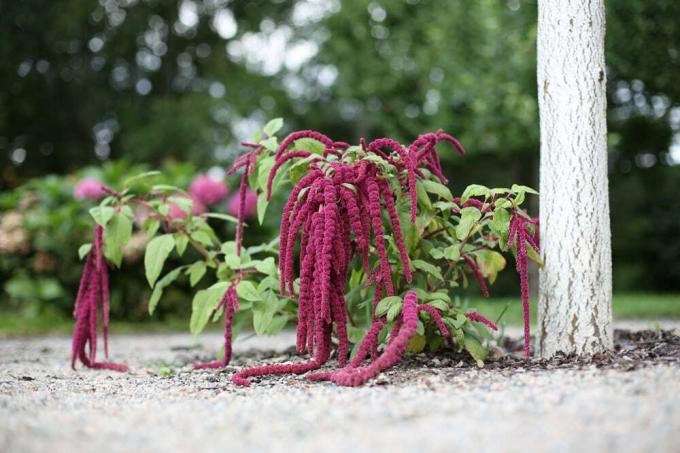
Also known as amaranth, foxtail is a cold-sensitive summer flower that grows in perennial form. Thanks to the attractive leaves and flowers, the plant has established itself worldwide, including in domestic gardens. Both upright and hanging varieties are available. The unusual name is due to the inflorescences that look like fox tails. Due to the stately height of some varieties, this fact should be planned before planting, so that the foxtail has enough space to unfold. The plant is extremely sensitive to frost, so it should not be planted out too early. Amarantda, which needs warmth, also has certain requirements when it comes to location so that it can thrive. Especially high-growing varieties need support with their sustained growth so that they do not break off due to gusts of wind.
- Depending on the variety, there are green, red, golden brown and purple inflorescences
- Decorative leaves are either red, brown, bronze, yellow or green
- Some varieties have multicolored mottled leaves
- Reach growth heights between 60-120 cm
- Only plant out after the ice saints
- Soil should be well drained
- Suitable as cut flowers for vases
- Needs full sun and sheltered from the wind
- Fertilize weekly from the beginning of summer
- Water additionally during dry periods
zinnias
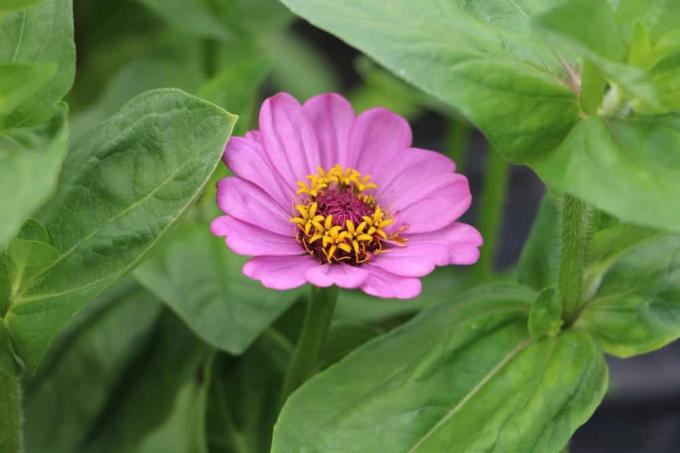
Zinnias are floriferous and warmth-loving plants that form dense flower cushions. These flowering perennials can be combined in many ways and fit well in colorful garden borders. Depending on the variety, the flowers can be very large. The small-flowered and low-growing varieties in particular form compact carpets of flowers, which consist of many individual flowers. The zinnias are relatively robust, but the plants should not be in an exposed location. However, zinnias are not suitable for self-sowing in the garden bed, as the seeds are very sensitive to frost. Therefore, the seeds should be collected before the onset of winter on a dry day for sowing in late spring. If additional watering is required due to drought, this should only be done in the morning and evening. Otherwise, remaining drops of water on the flowers and leaves may cause burns.
- Flowering time from June to the first frost
- Growth height between 15-100 cm
- The diameter of the flowers ranges from 2.5 to 15 cm
- Loves full sun locations
- Copes well with heat
- Withstands temporary soil drought
- Water additionally during long dry periods
- When planting, enrich the soil with compost
- Prefers well drained garden soil
- Also accepts slightly loamy soils
- Needs protection from strong gusts of wind
tagetes
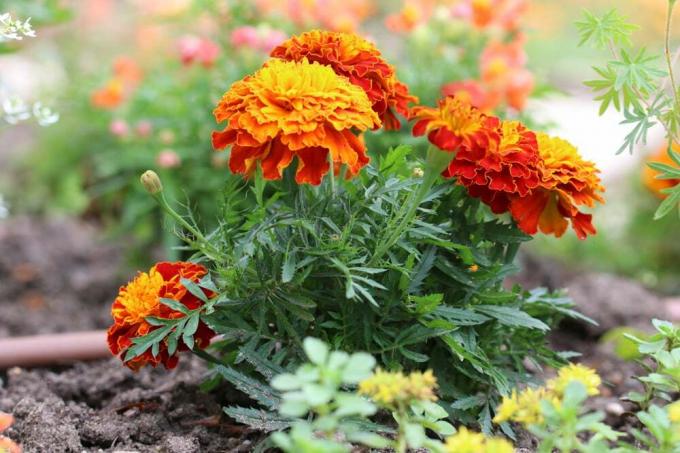
The marigolds please the eye of the gardener with a rich and long-lasting bloom. The plants are relatively undemanding, which is why they are also called student flowers. However, the site conditions and care must be right for the flowers to develop beautifully. Both short and tall varieties with large-sized flower balls are available. With the right care steps, the flowering period can be sustainably extended if the weather is still good in late autumn. The marigolds are characterized by a bushy growth, filigree leaves and cup-shaped inflorescences. However, marigolds are very sensitive to frost, so they should only be planted in the garden after the ice saints. However, the plants can easily be grown indoors, which means flowering doesn't take as long.
- Flowering time from early summer to autumn
- Flower colors vary from yellow to red to orange tones
- There are filled and unfilled flowers
- Remove faded flowers regularly to encourage flowering
- Tolerant to the location, full sun to partial shade is possible
- Needs airy and well-drained soil
- Keep soil evenly moist
- Avoid waterlogging and dryness
- Low nutrient requirements, only fertilize moderately
- Regularly remove dried flowers and leaves
summer aster
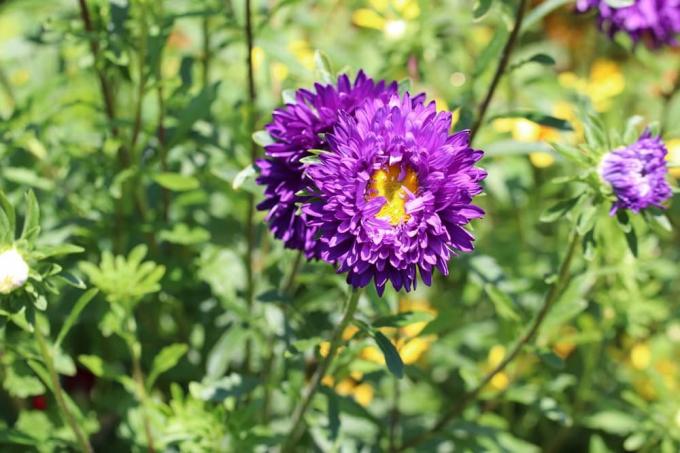
The summer asters bloom motley and bring a lot of color even to a dreary garden. With this annual daisy family, flower beds can be transformed into a veritable sea of flowers. There are both uniform shades and colorful mixtures that can be easily combined with other plant neighbors. Even when summer is slowly coming to an end, the summer asters will continue to bloom for some time. The plant is very sensitive to frost, so it should only be planted out after the ice saints. However, summer asters can easily be grown indoors and then moved outdoors. A problem can be susceptibility to fungal diseases, which lead to wilting plants. Affected plants should be disposed of immediately with household waste, and no more asters should be planted in the same place in the following years.
- Flowering time between July and October
- Flower colors are yellow, purple, pink, red and white
- Growth heights are between 20-70 cm
- A sunny to partially shaded location is ideal
- Prefers humic to sandy-loamy soil
- Keep soil evenly moist
- Absolutely avoid waterlogging
- Extremely low nutrient requirement
- Sow directly into the bed from mid-May
- Or prefer indoors from April
- Susceptible to the fungal disease aster wilt
Cape daisies
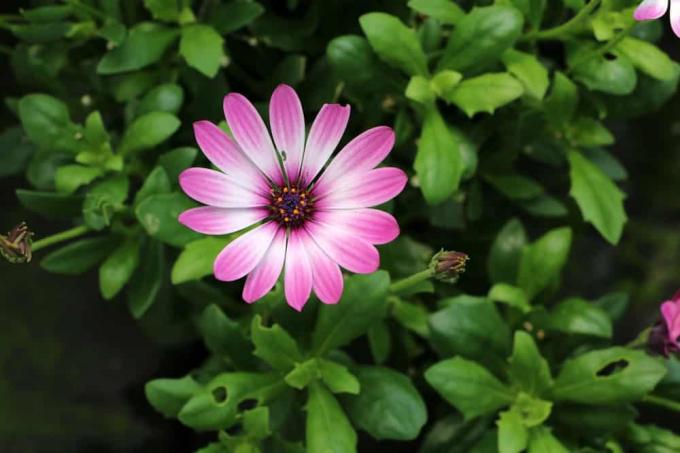
The Cape daisies originally come from Africa and therefore love the warmth. The plants are very sensitive to frost, but they flower for a long time throughout the summer. In terms of their flower shape, these are very similar to daisies and marigolds, but in many bright colours. The permanent bloomers should only go into the garden bed after the ice saints, but they can be preferred indoors. The plants themselves are relatively easy to care for, but the site conditions must be right. If there are too few hours of sunshine, the flowering will develop significantly less, a draughty place is just as bad. When the main bloom is over, the Cape daisies can be cut back. Then it sprouts again, with the formation of more flowers.
- Flowering period from June to October
- Flower Colors: Yellow, pink, purple, violet and white
- Growth height of 15-50 cm, depending on the variety
- Full sun locations are ideal
- Wind protection is very beneficial
- Need well drained garden soil
- Pay attention to even moisture
- Fertilize every 1-2 weeks during the growth phase
- Regularly removing faded flowers prolongs the flowering phase
- Pruning stimulates further flowering
petunias
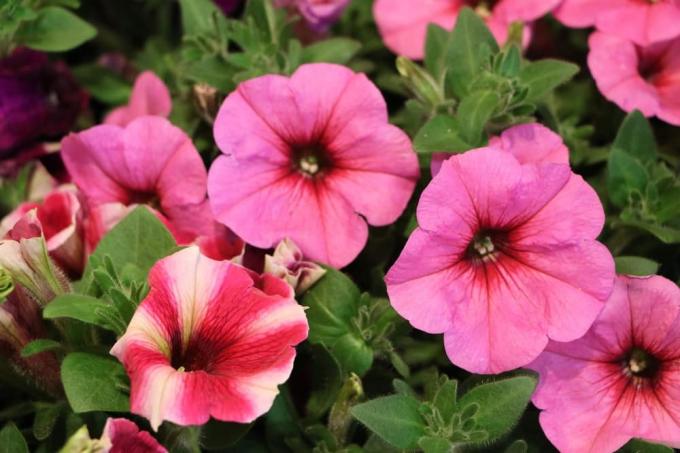
Petunias are annual flowering plants that are well suited for planting out in the home garden. The easy-care permanent bloomers are available in different colors and color combinations, some varieties are even patterned. In addition, the plants are divided into hanging and standing varieties. Petunias come from the tropical regions of South America and are therefore very sensitive to frost. For this reason, they are only allowed outside when no more frosts are to be expected. The darker the plants are, the less the sun-loving perennial flowers bloom. If the petunias are trimmed regularly, the reproduction of flowers is clearly stimulated. Although these bloom very profusely, they also wear out quickly, despite good care and plenty of fertilizer. It is therefore recommended to sow again after the first flowering phase. As a result, new plants are grown for another flowering period and the petunias flower much longer.
- Plant out from mid-May
- Flowering time from June until the first frost
- Blue, pink, fuchsia, lilac, white and black and yellow flowers
- Both single and double flowers
- Need full sun
- Pay attention to protection from too much wind and rain
- Water plentifully and regularly
- Soil must never dry out completely
- Absolutely avoid waterlogging
- Fertilize weekly
scented stone rich

The scented stone is a low and bushy perennial plant that produces an abundance of small and round flower heads. All varieties spread a slightly sweet and honey-like fragrance through their flowers, hence the descriptive name. The scented stone rich is ideal for planting in the themed rock garden. The robust perennial is very undemanding and provides an abundance of flowers in almost all locations. Due to its low growth height, it is ideal for edging garden beds. The plant can easily survive longer periods of drought. If you cut back in summer, you can stimulate a second flowering. Sowing in the garden on the spot is possible from April. Often reproduces by self-seeding and can grow in impossible places, for example in the cracks of sidewalks.
- Flower colors are pink, purple, violet and white
- Flowering period from June to September
- Grows as a dense cushion of flowers
- Rarely grew more than 15 cm
- Both full sun and partially shaded locations are possible
- Sow indoors in pots from March
- Plant outdoors from the end of May
- In case of severe drought, water additionally
- Fertilizing is not necessary
 garden editorial
garden editorial I write about everything that interests me in my garden.
Learn more about annual plants

Datura in the garden: 6 information on reporting requirements and toxicity
Beautiful but very dangerous. We are talking about datura (datura), an annual and above all poisonous perennial with high potential for reproduction. The strikingly prickly, globular and walnut-sized fruits are eponymous. The flowers are very similar to those of the trumpet tree, which is also poisonous.

Annual and biennial herbs - 10 popular varieties
The right ingredient for the main course is still missing? The salad needs to be rounded off or refined? How practical if you can get the right herbs from your own garden! But when cultivating, the question often arises: Which varieties can be grown as annuals or perennials - and which ones taste best?

Annual summer flowers: comprehensive list sorted by colour
Annual summer flowers beautify every garden with their colorful blossoms. The development of these plants is limited to the growing season, they germinate and die in a year or during a season. Many of the annual summer flowers come from the tropics, so their seeds are very sensitive to cold.
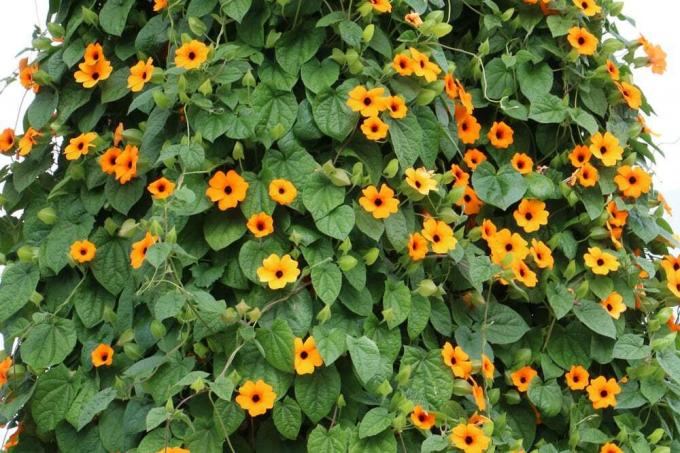
Annual climbing plants: 15 fast-growing and flowering plants
Annual climbing plants offer the same thing: quick and lush greenery for impatient gardeners, natural privacy screen for cozy spots or just decorative leaves and many colorful ones Blossoms. They are easy to cultivate and, with their variety of varieties, provide new variety every year.
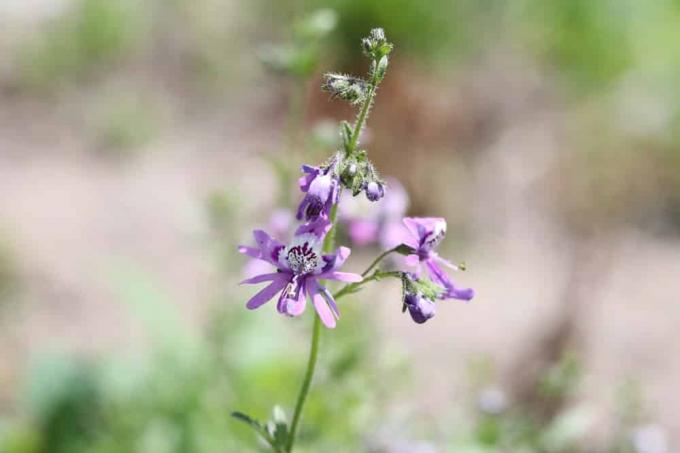
Caring for and overwintering farmer's orchid - schizanthus / split flower
Peasant orchid, split flower or schizanthus - as the orchid of the little man is also called, the nightshade plant enchants with its abundance of flowers and variety of colors. However, it can only do this if it is properly cared for and overwintered. Here we tell those who are interested what is important.
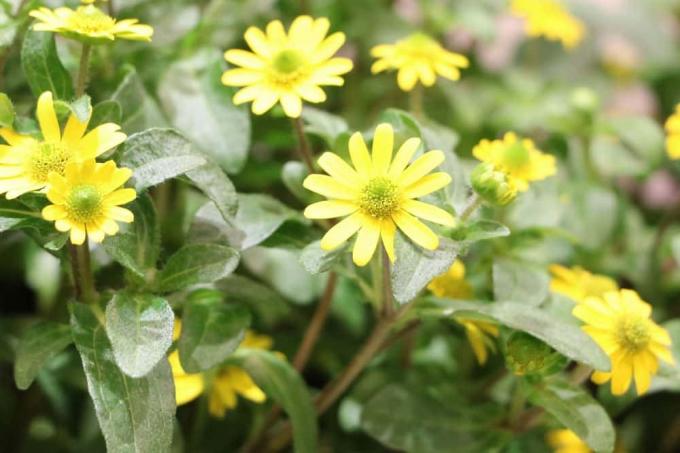
Hussar's Head, Sanvitalia – Care of Hussar's Head
The likeable hussar's head Sanvitalis procumbens blooms very persistently throughout the summer until the first frost. The garden, balcony and container plant is very easy to care for and constantly forms new buds. The blooms include all shades of yellow to orange flowers.



